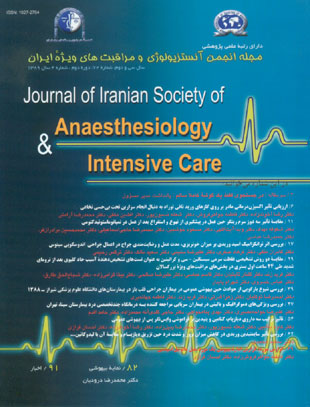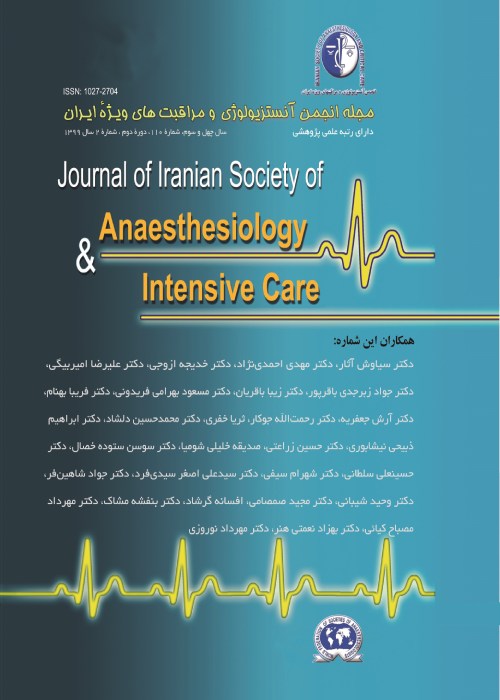فهرست مطالب

فصلنامه آنستزیولوژی و مراقبتهای ویژه ایران
سال سی و دوم شماره 4 (پیاپی 72، زمستان 1389)
- 88 صفحه،
- تاریخ انتشار: 1390/06/10
- تعداد عناوین: 12
-
-
سرمقاله: در جستجوی یک گوشه سالمصفحه 3
-
نمایه بیهوشیصفحه 72
-
اخبارصفحه 86
-
Page 6BackgroundCentral neuraxial block can impair respiratory function by paralysis of the breathing muscles due to a high block. Satisfactory regional anesthesia for Caesarean delivery requires a block level to at least the T4 dermatome and this can alter respiratory performance. Increasing inspired maternal oxygen may increase oxygen delivery to the fetus during general anesthesia or epidural and spinal anesthesia. The aim of this study is finding scientific evidence for oxygen efficacy on fetal oxygenation in cesarean procedure.Materials And MethodsThis study is performed on 100 pregnant patients who were candidate of cesarean section under spinal anesthesia. These patients were assigned into two groups (experimental and control, 50 cases in each group). For study group oxygen 6l/ml with mask was given after spinal anesthesia but the control group did not receive oxygen. Case and control group assessing with pulse oxymetery and neonatal VBG analysis. Comparison between the groups was performed with Chi-square and Paired T-test and Fisher test. All tests were performed by SPSS program.ResultsThe mean age of case and control group was 27.1 and 26.8 years. Maternal (p=0.0001) and neonatal (p=0.002) O2 saturation, PVO2 (P=0.00002), PVCO2 (P=0.0003) SVO2 (P=0.0001) had significant difference in cases and control groups. Apgar and pH, has not significant difference in cases and control group.ConclusionAccording to this finding, it is thought be the oxygen therapy is useful for fetal oxygenation. More study is necessary to find the better management method.Keywords: Spinal anesthesia, Cesarean section, Oxygen therapy
-
Page 11BackgroundPONV is a common complication after ENT surgeries (37-42%). Common drugs used for PONV prevention have different side effects. In recent studies preoperative fluid therapy has known as an effective method for PONV prevention.Materials And MethodsIn this double blind RCT 97 patients undergoing Tympanomastoidectomy surgery have assessed for incidence and severity of PONV and postoperative pain (POP) in 3 groups. Patients received 3 doses of ringer solution during anesthesia: 4cc/kg (G4, n=30), 10cc/kg (G10, n=33), 20cc/kg (G20, n=34)ResultsPatients in 3 groups was identical in mean age, mean weight, sex, anesthesia duration and anesthetic management. Incidence and severity of nausea and POP in G4 was significantly greater comparing with two other groups in a dose dependent manner. Only 3 cases had vomiting in G4 and not in two groups. Sore throat and dizziness in G4 were more than other groups but were not statistically significant.ConclusionSo because of more efficacy of 20cc/kg ringer solution to PONV and POP prevention than lower doses in patients undergoing Tympanomastoidectomy surgery and cost effectiveness and safety of this method, we propose this as a routine method in PONV and POP prevention in ASAΙ patients in moderate lasting surgeries (≈2һ)Keywords: PONV, Pain, Fluid therapy, Tympanomastoidectomy
-
Page 17BackgroundFunctional Endoscpoic Sinus Surgery (FESS) is regraded as one of the most common surgeries in the field of head and neck. As the site of surgery contains too much vessels, bleeding during surgery is often significant. The purpose of this study was to assess the effect of intravenous administration of tranexamic acid on bleeding during FESS.MethodsIn a randomized double-blinded placebocontrolled clinical trial, 50 patients with age of 18-50 years with ASA Class I or II who were candidated for elective FESS at Loghman Hospital in 2010 were randomly assigned into two groups of control and intervention. In the intervention group, after induction of anesthesia, 500 mg tranexamic acid was injected intravenously and the patient in control group received the same volume of saline as placebo, and surgery was performed under general anesthesia. Demographic and hemodynamic variables, besides the amount of bleeding during surgery, and surgeon’s satisfaction were recorded and compared.ResultsDemographic variables (including age, sex and weight) showed no significant differences. Changes in mean arterial pressure in the control group (p= 0.002) and intervention group (p= 0.014) during surgery showed a significant reduction, but the pattern of changes in control and intervention groups were similar (p= 0.99). The heart rate changes in the control group (p = 0.974) and intervention group (p = 0.512) during the operation showed no significant differences. In addition, the pattern of changes in control and intervention groups were similar (p= 0.938). Similar results on changes in the bleeding score in the control group (p= 0.167) and intervention group (p= 0.50) and the pattern of change in control and intervention groups (p= 0.366) and surgeon’s satisfaction score changes in control group (p = 0.415) and intervention group (p= 0.682) and the changing pattern in the two groups were obtained (p= 0.658).ConclusionsUsing Tranexamic acid 500 mg intravenously before starting FESS does not make any changes in surgical bleeding and surgeon’s satisfaction.Keywords: Hemorrhage, Surgeon's satisfaction, Functional Endoscpoic Sinus Surgery, Tranexamic acid
-
Page 29BackgroundAcute kidney injury (AKI) is a common clinical problem in critically ill patients such as post traumatic situations. One of the main causes of poor outcome in these patients is lack of valuable serum markers for early diagnosis of AKI. In this study we compared cystatin-C and creatinine for estimation of GFR as a markers of AKI.Materials And Methodswe prospectively evaluated 300 patients admitted in adult intensive care units of a referral university affiliated hospital. Serum cystatin -C and serum creatinine were used to assess renal function according to RIFLE criteria to diagnose AKI.ResultsThe crude Incidence of AKI according to RIFLE criteria based on GFR calculated with Creatinine was 14.7% and based on GFR with cystatin-C was 7%. Creatinine level was increased better than cystatin-C in the first 24 hours.DiscussionAKI can be diagnosed by Creatinine level better than cystatin-C in the first 24 hours, so it is a better markers for evaluation of AKI.Keywords: Acute kidney injury, Cystatin, C, Creatinine, RIFLE
-
Page 39BackgroundAwareness during anesthesia is one of the important events that has particularly become more common with the advent of muscle relaxants. Awareness during anesthesia can lead to certain, psychological problems. As to monitor and maintain adequate depth of anesthesia is considered to be one of the most important task of an anesthesiologist, we decided to determine the incidence of awareness in the patient undergoing an open heart surgery.Materials And MethodsIn this prospective study, patients scheduled for open heart surgery in hospital of shiraz university of medical sciences at 2ed half of 1388, were interviewed 24 hours after surgery in order to determine the incidence of awareness during anesthesia. Patients below 15 years, patients who had difficulty in verbal communication and patients who were not extubated after 24 hours due to complication of operation, were excluded.ResultsFrom 305 patients, this study revealed an overall awareness of 2/3%, of which 1/3% had auditory memory and. /7% dreaming and. /33% pain recall.ConclusionIn respect to this study, awareness during open heart surgery is 2/3%. We recommend advanced researches to evaluate correlation between time of awareness and time of cardiopulmonary by pass, effective factors in awareness prevention of awareness.Keywords: Anesthesia, Awareness, Recall, Cardiac surgery
-
Page 47BackgroundThis study was done to investigate demographic and clinical charac-teristics of patients attending a multi-disciplinary pain clinic.Materials And MethodsA retrospective study on the questionnaires completed by consecutive new patients presenting to the pain clinic was performed and the results were analyzed statistically.ResultsMost of the patients had a prolonged history of chronic severe pain. A great majority of patients had previous physician visits and were taking medications at the time of presentation to pain clinic but only a small proportion of them had experienced improvement. One-sixth of patients had been operated upon because of pain. The mean average pain score was higher in older patients and among female attendees. The degree of interference of pain with daily activities was lower in the older and the female patients. The degree of interference with social, recreational and familial activities was lower among patients in spousal relationship and in more educated ones, but was positively related to increasing age.ConclusionThe findings of this study show that many factors including age, gender, marital status and education may influence different aspects of pain, which should be taken into consideration in the management of patients in pain.Keywords: Pain, Pain clinic, Demographic charac, teristics, Clinical characteristics
-
Page 54BackgroundInformation about retrograde amnesia in the perioperative period is scarce. The amnesia produced by anesthesia is advantageous for unpleasant events like awareness under anesthesia or an uncomfortable feeling in the recovery room. It may be difficult to clear the memory that has been stored in the brain. The aim of this study is to induce retrograde amnesia with ketamine, diazepam, and pethidine.Materials And Methods150 patients aged 18 to 35 years (ASA I) undergoing surgery and general anesthesia were included in this study. In the postanesthesia care unit (PACU), each patient underwent identical auditory, visual, and sensory stimulus. Then the drugs were administered. There were 50 patients in each of three groups: the first group ketamine 0.3 mg/kg in addition to diazepam 0.1 mg/kg and pethidine 0.3 mg/kg; the second group ketamine 0.5 mg/kg in addition to diazepam and pethidine; and the control group. After the patients became awake again and before being discharged from PACU and also10 hours after discharge, the memory of the patients was evaluated.ResultsAll (100%) patients in control and low dose ketamine groups were able to remember the day events. Among patients who received 0.5 mg/kg of ketamine two were unable to remember all the stimulus before drug administration (p=0.13); and besides three were unable to remember the visual stimulus only. The rest of 45 patients in this higher dose ketamine group remembered all the events and the stimulus.ConclusionThere was no evidence of retrograde amnesia with the combination of diazepam, ketamine, and pethidine; administered in the mentioned doses. Amnesia for visual stimulus was statistically significant (p=0.028).Keywords: Retrograde amnesia, Diazepam, Ketamine
-
Page 62BackgroundIt has been shown that antihistamines prolong the duration of antinociceptives. The aim of this study was to compare the efficacy of cimetidine and lidocaine in decreasing pain prevalence and intensity during diazepam injection as anesthesia premedication.Materials And MethodsIn a randomized, double-blinded, placebo - controlled prospective study, 60 ASA I & II patients scheduled for elective surgery under general anesthesia in Imam Khomeini Hospital in 1382 were enrolled. Patients with history of drug abuse or narcotic drug consumption or psychological disorders were excluded from the study. They were randomly assigned into three groups, case group (received 2ml of normal saline), lidocaine group (received 40 mg lidocaine) and cimetidine group (received 200 mg cimetidine) intravenously prior to diazepam injection. Pain intensity was measured using VAS system and patients were followed the day after surgery for thrombophelebitis.ResultsThe age mean was 32.7±9.5. There was no significant difference in mean of age, weight, gender and ASA status between groups (p>0.05). The pain mean during diazepam injection in lidocaine and cimetidine groups were significantly lower than case group (1.50 and 1.90 vs. 5.30 respectively, p<0.05) but there was no significant difference between lidocaine and cimetidine groups (p>0.05). Also there was no significant difference in thrombophelebitis occurrence between groups (20% & 5% vs. 15% respectively, p>0.05).ConclusionsIntravenous administration of cimetidine before diazepam IV injection, results decreasing in pain on injection of diazepam.Keywords: Cimetidine, Lidocaine, Pain on injection
-
Page 69Methylmalonyl – coenzyme A deficiency is an inborn error of metabolism that can result in the formation of methylmalonic acidemia. Experience with anesthesia is limited, and recommendations are based more on theory than on clinical experience. This study demonstrated a 4 years old boy with methylmalonyl acidemia. Then the presentation of this patient we will discussed management of anesthesia.Keywords: Methylmalonyl acidemia, Management of anesthesia, Hypoglisemia


